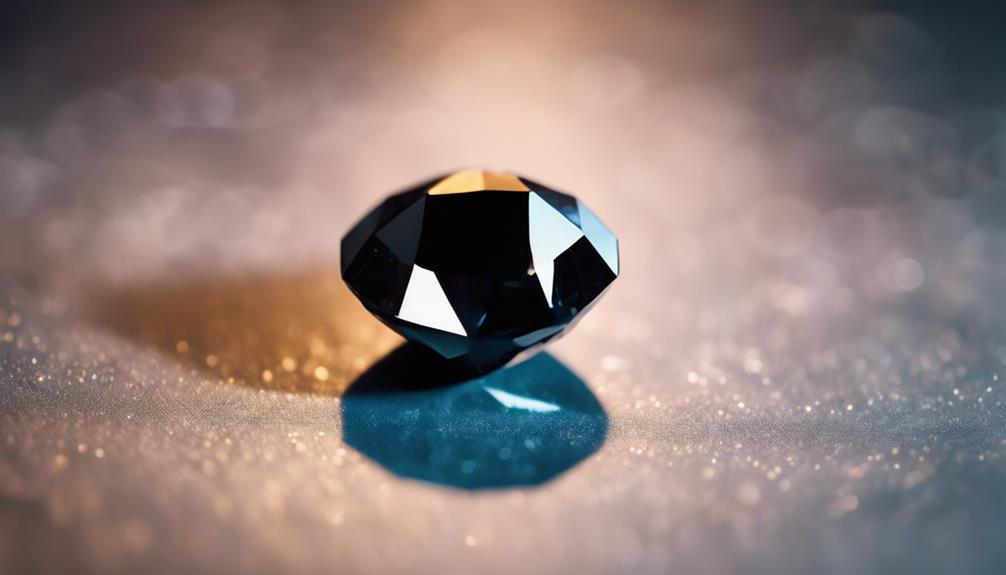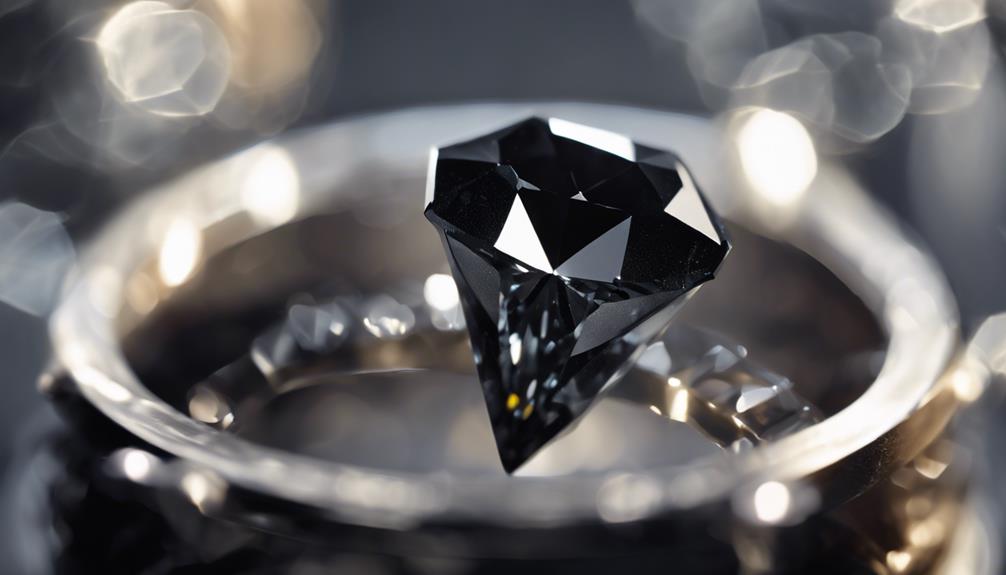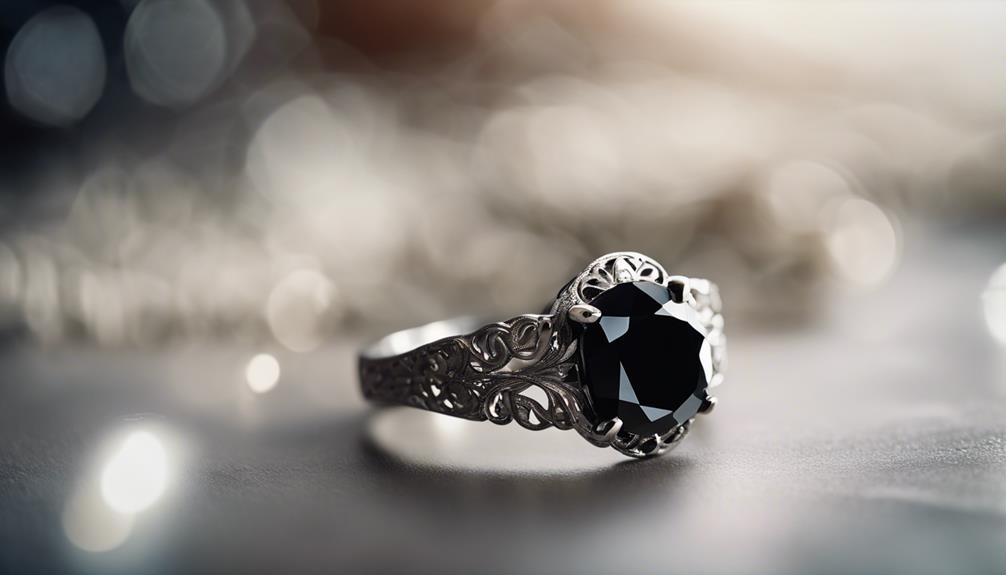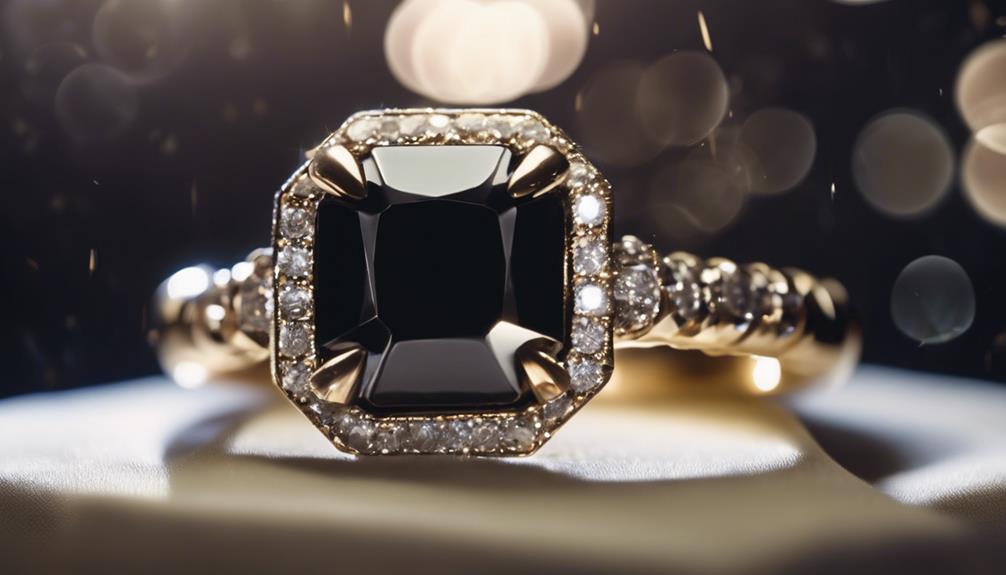When buying black diamonds, you’ll want to look for natural stones, which have unique inclusions like graphite, or treated ones, altered using heat and pressure. Make certain you get a certification from reputable gemological labs to verify authenticity. Natural black diamonds cost more, averaging $2,400 per carat, while treated ones start at around $300 per carat. Pay attention to the diamond’s cut and shape, and choose a reputable retailer with great reviews. Ideal settings, such as halo or solitaire, can amplify the diamond’s dramatic, opaque beauty. For a thorough understanding and expert tips, further insights await.
Understanding Black Diamonds

Black diamonds, which are often admired for their deep, opaque appearance, stand out due to their ability to absorb light rather than reflect it. When you look at a black diamond, you’re seeing a gemstone that’s unique in its light-absorbing qualities. Natural black diamonds are even more intriguing because they contain inclusions like graphite, pyrite, or hematite. These inclusions give the diamonds their black color, making them highly valuable and desirable.
In contrast, treated black diamonds start out as white diamonds. They undergo processes like heat, pressure, and irradiation to achieve their black hue. These treatments usually involve diamonds with inclusions and fractures, transforming them into the striking black stones you see. Because of these treatments, certification from reputable gemological labs is essential. It guarantees you’re getting exactly what you’re paying for, especially since the market is flooded with treated stones.
Price-wise, black diamonds are generally more affordable than their colorless counterparts. You’ll find treated black diamonds starting around $300 per carat, while natural black diamonds can average around $2,400 per carat. This makes them an attractive option if you’re seeking something unique without breaking the bank.
Origin and Composition
When exploring the origin and composition of these enchanting gemstones, you’ll find that graphite plays a notable role in their deep black coloration. Natural black diamonds are packed with inclusions, particularly graphite, which gives them their distinctive hue. These inclusions cause the diamond to absorb light rather than reflect it, resulting in their opaque appearance.
Black diamonds are composed of many small crystals arranged in random formations. This unique structure contributes to their exceptional hardness, making them even tougher than most colorless diamonds. They score a perfect 10 on the Mohs scale of mineral hardness, meaning they’re incredibly durable and resistant to scratches.
Unlike other diamonds that are typically clear and transparent, black diamonds owe their color to the high levels of inclusions within them. This makes each black diamond unique, as the pattern and type of inclusions can vary considerably from one stone to another. The presence of these inclusions not only contributes to the diamond’s color but also adds to its charm and individuality.
Understanding the origin and composition of black diamonds guarantees you appreciate their unique beauty and durability, setting them apart from other gemstones in the market.
Intensity and Aesthetics

Fancy black diamonds captivate with their singular intensity, offering a bold and striking aesthetic that stands out in any jewelry piece. Unlike other colored diamonds, black diamonds are classified under one intensity level: fancy black. This unique intensity sets them apart, creating a dramatic visual impact that’s perfect for modern jewelry designs.
When you look at a black diamond, its deep, opaque hue immediately commands attention. The stone’s ability to absorb light rather than reflect it gives it a mysterious and alluring quality. This intensity often creates a stunning contrast when paired with colorless diamonds, enhancing the overall appeal of the piece. Whether set in engagement rings, earrings, or bracelets, black diamonds bring an element of sophistication and edge.
Their bold appearance isn’t just about color; it’s about the statement they make. In jewelry settings, black diamonds are frequently showcased as the centerpiece, often surrounded by smaller, colorless diamonds to amplify their striking presence. The singularity of their color enhances their allure, making them a popular choice for those seeking something different yet timeless.
Purchasing Tips
To make an informed purchase, prioritize certification from reputable gemological labs to verify the quality and authenticity of black diamonds. Certifications from labs like GIA or AGS confirm you’re getting a natural black diamond rather than a treated one, providing peace of mind and value for your investment.
Next, consider your budget. Natural black diamonds are generally more expensive than treated ones, so knowing your financial limits helps narrow down your options. Treated black diamonds offer a cost-effective alternative without compromising on aesthetic appeal.
When evaluating black diamonds, pay attention to the cut and shape. While black diamonds don’t have the same sparkle as colorless diamonds, a well-cut stone will maximize its unique beauty. Popular shapes include round, princess, and cushion cuts.
Choose a reputable retailer. Vendors like Leibish & Co. and James Allen are known for their extensive selection and high-quality images, allowing you to scrutinize the diamond before purchase. Look for detailed listings and customer reviews to gauge reliability.
Jewelry Settings and Symbolism

Black diamonds shine brightest in jewelry settings that highlight their unique intensity and dramatic flair. When choosing a setting, you’ll want to make sure the design enhances the diamond’s bold appearance. Here are three popular settings to take into account:
- Halo Settings: Surround your black diamond with a circle of smaller, colorless diamonds. This contrast amplifies the dark stone’s allure, making it a stunning centerpiece.
- Side Stone Settings: Position smaller diamonds alongside your black diamond. This creates a balanced design that emphasizes the main stone while adding extra sparkle.
- Solitaire Settings: Let the black diamond stand alone as the star of the show. A simple band in white gold, platinum, or even rose gold can make the diamond’s intense color truly pop.
Black diamonds pair well with various metals, including 14k white gold, platinum, rose gold, and yellow gold, allowing you to customize your piece to your taste.
The symbolism behind black diamonds adds another layer of appeal. They represent eternal love, passion, action, and energy, making them a meaningful choice for significant milestones and declarations of commitment.
When you choose the right setting, your black diamond jewelry won’t only be a striking accessory but also a symbol of powerful emotions.
Conclusion
By now, you’ve got a solid grasp on what makes black diamonds so special.
With your newfound knowledge, you’re ready to confidently choose a black diamond that matches your style and quality standards.
Remember, whether it’s for an engagement ring, a necklace, or earrings, these unique gems will add a touch of bold elegance to any piece.
So go ahead and make your purchase with confidence, knowing you’ve made an informed decision.
Happy shopping!



